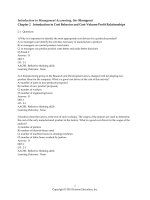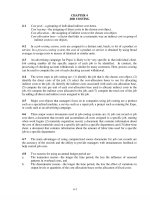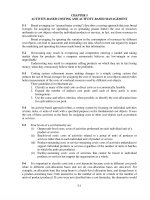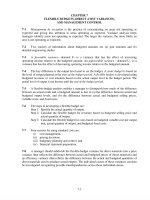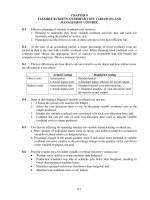Solution manual introduction to management accounting 14e by horngren ch14
Bạn đang xem bản rút gọn của tài liệu. Xem và tải ngay bản đầy đủ của tài liệu tại đây (364.17 KB, 40 trang )
To download more slides, ebook, solutions and test bank, visit
CHAPTER 14
COVERAGE OF LEARNING OBJECTIVES
LEARNING OBJECTIVE
LO1: Distinguish between
job-order costing and
process costing.
LO2: Prepare summary
journal entries for the
typical transactions of a jobcosting system.
LO3: Use an activity-basedcosting system in a joborder environment.
LO4: Show how service
organizations use job
costing.
LO5: Explain the basic ideas
underlying process costing
and how they differ from
job costing.
LO6: Compute output in
terms of equivalent units.
LO7: Compute costs and
prepare journal entries for
the principal transactions in
a process-costing system.
LO8: Demonstrate how the
presence of beginning
inventories affects the
computation of unit costs
under the weighted-average
method.
LO9: Use backflush costing
with a JIT production
system.
FUNDAMENTAL
ASSIGNMENT
MATERIAL
A1,B1
CRITICAL
THINKING
EXERCISES
AND
EXERCISES
16,18,20,29
PROBLEMS
22,25
41
17,23
42
30
52
A2,B2
31,32,33,36
44,45,46,47
A2,B2
32,33,34,35,3
7,38
43,45,46,47
A3,B3
A4,B4
48
19
841
CASES,
NIKE 10K,
EXCEL,
COLLAB. &
INTERNET
EXERCISES
49,51,52
50
To download more slides, ebook, solutions and test bank, visit
JOB-COSTING AND PROCESS-COSTING SYSTEMS
14-A1 (15-20 min.) Answers are in thousands.
1.
a.
b.
c.
d.
e.
f.
g.
Direct materials inventory
Cash
360
Work in process inventory
Direct materials inventory
330
Work in process inventory
Accrued payroll
125
Factory department overhead control
Various accounts
(80 + 55 + 40 = 175)
175
Work in process inventory
Factory department overhead
control
(180% x 125)
225
Finished goods inventory
Work in process inventory
625
Cost of goods sold
Finished goods inventory
400
842
360
330
125
175
225
625
400
To download more slides, ebook, solutions and test bank, visit
2.
Direct Materials Inventory _
Finished Goods Inventory ___
a.
360 b.
330 f.
625 g.
400
* Bal.
30
* Bal.
225
Work in Process Inventory
b.
330 f.
625
c.
125
e.
225
680
* Bal.
55
d.
* 12/31/X7 Balance
843
Cost of Goods Sold____
g.
400
Factory Department
Overhead Control _____
175 e.
225
To download more slides, ebook, solutions and test bank, visit
14-A2 (10-15 min.)
1.
Flow of Production
Started and completed
Work in process, ending inventory
Direct materials added: 2,000 x 1
Conversion costs added: 2,000 x .5
Total accounted for
(Step 2)
(Step 1)
Equivalent Units
Physical Direct Conversion
Units Materials Costs
17,000
17,000 17,000
2,000
2,000
1,000
19,000
Total work done
Total costs to account for (Step 3):
Divide by equivalent units (Step 4)
Unit costs
$
2.
19,000 18,000
$150,800 $60,800 $90,000
19,000 18,000
8.20 $ 3.20 $ 5.00
Totals
Application of costs (Step 5):
To units completed and transferred to
Testing, 17,000 units ($8.20)
To units not completed and still in
process, Feb. 28, 2,000 units:
Direct materials
Conversion costs
Work in process, Jan. 31
Total costs accounted for
844
Details
$139,400
$ 6,400 2,000($3.20)
5,000
1,000($5.00)
$ 11,400
$150,800
To download more slides, ebook, solutions and test bank, visit
14-A3
(25-30 min.)
(Step 2)
(Step 1)
_ Equivalent Units___
Physical
Direct Conversion
Flow of Production
Units
Materials Costs
Work in process, beg. inv.
10,000 (25%)*
Started
80,000
To account for
90,000
Completed and transferred out
during current period
70,000
70,000 70,000
Work in process, end. inv.
20,000 (50%)*20,000 10,000
Units accounted for
90,000
Work done to date
90,000 80,000
___ _Details
__
Direct Conversion
Totals Materials
Costs
Costs
Work in process, beg. inv.
Costs added currently
(Step 3) Total costs to account for
(Step 4) Divisor, equivalent units for
work done to date
Cost per equivalent unit
$
(Step 5) Application of Costs
Completed and transferred
(70,000 units)
Work in process, ending inv.
(20,000 units):
Direct materials
Conversion costs
Total work in process
Total costs accounted for
*Degree of completion for conversion costs.
845
$ 175,500 $138,000 $ 37,500
1,486,500 852,000 634,500
$1,662,000$990,000$672,000
÷ 90,000 ÷ 80,000
19.40 $ 11.00 $ 8.40
$1,358,00070,000 ($19.40)
$ 220,000 20,000($11.00)
84,000
10,000($8.40)
$ 304,000
$1,662,000
To download more slides, ebook, solutions and test bank, visit
14-A4 (15-20 min.)
1.
2.
Materials inventories
Accounts payable
45,000
Conversion costs
Accrued payroll
Miscellaneous accounts
30,000
Finished goods inventories (2,000 x $37)
Materials inventories (2,000 x $22)
Conversion costs (2,000 x $15)
74,000
Cost of goods sold (1,980 x $37)
Finished goods inventories
73,260
45,000
Cost of goods sold
Conversion costs
To recognize actual conversion costs that were
$3,000 greater than the amount applied to the
products.
846
11,000
19,000
44,000
30,000
73,260
3,000
3,000
To download more slides, ebook, solutions and test bank, visit
14-B1
(20-25 min.) Entries are in British pounds (£).
1.
Direct materials inventory
Accounts payable
a.
b.
c.
d.
e.
f.
g.
h.
Work in process inventory
Direct materials inventory
Work in process inventory
Accrued payroll
Factory department overhead control
Various accounts, such as cash or
accounts payable
109
109
95
95
105
105
90
90
Work in process inventory
84
Factory department overhead control
Finished goods inventory
Work in process inventory
280
Cost of goods sold
Finished goods inventory
350
Accounts receivable
Sales
600
84
280
350
600
847
To download more slides, ebook, solutions and test bank, visit
2.
Direct Materials Inventory
* Bal.
18
b. 95
a.
109
* Bal.
32
Finished Goods Inventory_
* Bal.
100 g.
350
f.
280
* Bal.
30
Work in Process Inventory
* Bal.
25 f.
280
b.
95
c.
105
e.
84
309
* Bal.
29
Cost of Goods Sold
g.
350
Factory Department
Overhead Control
d.
90 e.
84
* 12/31/X7 Balance
848
To download more slides, ebook, solutions and test bank, visit
14-B2
(10-15 min.)
1.
(Step 2)
Equivalent Units
(Step 1)
Flow of Production
Started and completed
Work in process, ending inv.
Units accounted for
Units work done to date
Total costs to account
for (Step 3)
$675,000
Divide by equivalent
units (Step 4)
Unit costs
Physical
Units
Direct Conversion
Materials Costs
600,000
300,000
900,000
600,000
300,000
600,000
150,000*
900,000
750,000
$2,295,000 $1,620,000
$2.70
900,000 750,000
$1.80
$ .90
*300,000 x .5
2.
Application of costs (Step 5):
Totals
To units completed and
transferred to Finishing,
600,000 units ($2.70)
$1,620,000
To units not completed and still
in process, end, 300,000 units:
Direct materials
$ 540,000
Conversion costs
135,000
Work in process, end
$ 675,000
Total costs accounted for
$2,295,000
849
Details
300,000 ($1.80)
150,000($.90)
To download more slides, ebook, solutions and test bank, visit
14-B3
(25-35 min.)
(Step 1)
Flow of Production
Work in process, beg. inv.
Started
To account for
Completed and transferred
out during current period,
550 + 7,150 – 400
Work in process, end. inv.
Units accounted for
Work done to date
Costs
Work in process, beg. inv.
Costs added currently
(Step 3) Total costs to account for
(Step 4) Divisor, equivalent units
For work done to date
Cost per equivalent unit
(Step 2)
____Equivalent Units____
Physical
Direct
Conversion
Units
Materials
Costs
550 (40%)*
7,150
7,700
7,300
400 (20%)*
7,700
7,300
400
7,300
80
7,700
7,380
__Details _____
Direct Conversion
__Totals_ Materials
Costs
$ 5,104
101,064
$106,168
$ 3,190
65,340
$68,530
$ 1,914
35,724
$37,638
$14.00
÷ 7,700
$8.90
÷ 7,380
$5.10
(Step 5)
Application of Costs
Completed, (7,300 units)
$102,200
Work in process, ending inventory
(400 units):
Direct materials (400)
$ 3,560
Conversion costs (80)
408
Total work in process
$ 3,968
Total costs accounted for
$106,168
*Degree of completion for conversion costs.
850
7,300 ($14.00)
400($8.90)
80($5.10)
To download more slides, ebook, solutions and test bank, visit
14-B4
1.
(15 min.)
Materials inventories
Accounts payable
15,500
15,500
Conversion costs
Accrued payroll and
mscellaneous accounts
6,300
Cost of goods sold (1,500 x $14)
21,000
Materials inventories (1,500 x $9.80)
Conversion costs (1,500 x $4.20)
2.
Conversion costs
300
Cost of goods sold
To recognize actual conversion costs that were
$300 less than the amount applied to the products.
851
6,300
14,700
6,300
300
To download more slides, ebook, solutions and test bank, visit
14-1 Three purposes of product costing are to satisfy differing
demands for (a) inventory valuation and income determination in
accordance with generally accepted accounting principles, (b)
income tax reporting, and (c) guiding strategic and operational
decision-making.
14-2 The distinction between the job cost and the process cost
methods centers largely around how product costing is
accomplished. Unlike process costing, which deals with broad
averages and great masses of like units, the essential feature of the
job-cost method is the attempt to apply costs to specific jobs that
may consist of either a single physical unit (a custom sofa) or a few
like units (a dozen tables) in a distinct batch or job lot.
14-3 The basic record for the accumulation of job costs is the jobcost sheet or job-cost record. Exhibit 14-1 shows a Job-Cost Sheet,
and it also shows the related source documents. A file of current
job-cost sheets becomes the supporting details for the Work-inProcess Inventory account.
14-4 Source documents include materials requisitions and labor
time tickets (time cards).
14-5 Examples of service industries that use the job-costing
approach include repairing, consulting, legal, accounting, painting,
dentistry, and income tax preparation.
14-6 No, the amount of value-chain activity not captured in either
job-cost or process-cost systems is independent of the type of
operating system used.
14-7 Examples of process costing include flour, glass, paint, and
beer.
852
To download more slides, ebook, solutions and test bank, visit
14-8 Examples of process costing include handling of mail, income
tax returns, automobile registrations, and drivers license
examinations.
14-9 Five key steps in process cost accounting are
Step 1:
Summarize the flow of physical units
Step 2:
Calculate output in terms of equivalent units
Step 3:
Summarize the total costs to account for, which are
the total debits in Work in Process (that is, the costs applied to
Work in Process)
Step 4:
Calculate unit costs
Step 5:
Apply costs to units completed and to units in
ending work in process
14-10 The first two steps concentrate on what is occurring in
physical or engineering terms. The financial impact of the
production process is measured in the final three steps.
14-11 (1 x 10,000) + (.5 x 5,000) = 12,500 full-time-equivalent
students.
14-12 Beginning inventories + Units started = Units transferred out
+ Ending inventories.
14-13 Transferred-in costs are accounted for operationally the same
as direct materials added at the beginning of a production process.
They differ from direct material costs because they are a
combination of direct material and conversion costs from a previous
department; thus, calling them a direct-material cost is
inappropriate.
14-14 When actual conversion costs exceed the amount applied, the
excess in the conversion cost account is charged directly to cost of
goods sold; the treatment is similar to accounting for underapplied
overhead.
853
To download more slides, ebook, solutions and test bank, visit
14-15 In addition to inventory valuation and income determination,
managers want accurate job costs as guides to pricing and to
allocating effort among particular products, services, or customers.
They are also necessary in contracts that reimburse the cost of a
product or service.
14-16 The most important point is that product costing is an
averaging process. The unit cost used for inventory purposes is the
result of taking some accumulated cost and dividing it by some
measure of production. The basic distinction between job order
costing and process costing is the breadth of the denominator: in
job order costing, it is small (for example, one painting, 100
advertising circulars, or one special packaging machine); but in
process costing, it is large (for example, thousands of pounds,
gallons, or board feet).
14-17 No. Some service firms trace only direct-labor costs to
individual jobs. However, with advances in computer technology
and needs for better job-cost information because of competition,
more service firms are tracing additional costs to jobs. The more
costs that are traced to jobs instead of being allocated, the more
accurate are the job costs.
14-18 The central product costing problem in process costing is how
each department should compute the cost of goods transferred out
and the cost of goods remaining in the department.
14-19 No, but they are especially appropriate for companies with
just-in-time systems. Any company with small inventories might
find backflush costing appealing.
14-20 (5 min.)
a. and d. are service-sector companies
b. is merchandising
854
To download more slides, ebook, solutions and test bank, visit
c. is manufacturing
14-21 (10-15 min.) You may wish to use T-accounts. Amounts are
in millions of dollars. You can also use the expression: ending
balance (of any account) equals the beginning balance plus additions
less subtractions or EB = BB + A - S. In this case “Purchased” is
“additions” and “Used” is “subtractions.”
1.
8 + 5 - 7 = 6 (BB + A - S = EB)
2.
8 + 9 - 6 = 11 (BB + A - EB = S)
3.
5 + Purchases - 7 = 8. Purchases = 10
4.
Beginning inventory + 8 - 3 = 7.
Beginning inventory = 2
14-22 (10-15 min.) Amounts are in thousands of dollars.
1.
Finished goods inventory
Work in process inventory
Finished goods = 72 + 56 = 128
2.
Debits: 12 + 50 + 25 + 55 =
Credits: 72 + 56 =
Balance, April 30
3.
Accounts receivable
Sales
Sale of Job A13
128
128
142
128
14
101
101
Cost of goods sold
Finished goods inventory
Cost of Job A13 sold
855
72
72
To download more slides, ebook, solutions and test bank, visit
14-23 (10-15 min.)
Cancer Research Project
Medical School
Unit
Reference
Date
Quantity Cost Amount Summary
Direct Materials:
Var. medical supplies Jan. 5
Various chemicals
Jan. 7
Direct Labor:
Research associates
Research assistants
Project overhead
applied
Total costs
$ 925
780
$ 1,705
Jan. 5-12 120 hrs. $32 $3,840
Jan. 7-12 180 hrs. $19 3,420
7,260
Jan. 12
14-24 (10 min.)
1.
$6,500 + $3,900 = $10,400
2.
$8,100
3.
$3,200 + $8,800 = $12,000
856
$7,260 x .70 $5,082
5,082
$14,047
To download more slides, ebook, solutions and test bank, visit
14-25 (15 min.) Answers are in thousands of dollars.
1.
a
b
c
a
b
c
Construction Finished Cost of Construction Finished Cost of
in Process Houses, Houses in Process Houses, Houses
Job No. Sept. 30 Sept. 30 Sold Sept. Oct. 31
Oct. 31 Sold Oct.
43
180
51
170
52
150
150
53
200
2501
61
115
1352
62
180
2053
71
118
1544
81
106
___
___
1545
___
___
719
150
350
308
135
605
1
200 + 50
2
115 + 20
3
180 + 25
2.
Finished houses inventory
Construction in process
Sept.: 180 + 170 + 150 = 500
Oct.: 250 + 135 + 205 = 590
3.
Cash
4
118 + 36
5
106 + 48
Sept. __ Oct.__
500
590
500
590
345
Sales
To record sale of Job 53
345
Cost of houses sold
Finished houses inventory
To record cost of Job 53 sold
857
250
250
To download more slides, ebook, solutions and test bank, visit
14-26 (30 min.)
The answers (in millions) are $15, $5, and $240.
Step-by-step entries are keyed alphabetically. The sequence
depends on where the student prefers to start. You may wish to
raise the question of whether the underapplied overhead should be
prorated among the affected accounts at the end of the year.
__Direct Materials__
Bal.
15 (a) 210
(b)
225
240
210
Bal.
30
Finished Goods
Bal. 240 (f)
500
(e) 420
___
660
500
Bal. 160
Work in Process
Bal.
5 (e) Completed 420
(a) Dir. Materials
210
(c) Dir. Labor
125*
(d) Applied overhead 200
___
540
420
Bal.
120
Cost of Goods Sold
(f)
500
* $200 160% = $125
858
To download more slides, ebook, solutions and test bank, visit
14-27 (30 min.)
The answers (in millions) are $25, $22, and $32.
Step-by-step entries are keyed alphabetically. The sequence
depends on where the student prefers to start. You may wish to
raise the question of whether the underapplied overhead should be
prorated among the affected accounts at the end of the year. Note
the heavy ending Finished Goods.
Direct Materials
Bal.* 25 (a) 235
(b) 275
300
235
Bal. 65
Work in Process
Bal.*
22 (e) Completed 493
(a) Dir. Materials
235
(c) Dir. Labor
100
(d) Applied overhead 150
507
493
Bal.
14
Finished Goods
Cost of Goods Sold
Bal.* 32 (f)
350
(f)
350
(e) 493
525
350
Bal. 175
* Let BB = beginning balance
Direct materials: BB + 275 – 235 = 65
BB = 25
Work in process: BB + 235 + 100 + 150 – 493 = 14
BB = 22
Finished goods: BB + 493 – 350 = 175
BB = 32
14-28 (5-10 min.)
Case A, $3,600,000 ÷ $2,000,000 = 180% of direct-labor cost
Case B, $5 x 450,000 = $2,250,000
Case C, $1,500,000 ÷ 250,000 = $6 per machine hour
859
To download more slides, ebook, solutions and test bank, visit
14-29 (5 min.)
Coca-Cola and Nally and Gibson are manufacturing companies. U.
S. Post Office and Mckensey and Co. are service companies.
14-30 (5 min.)
(1) The debit to the work in process account when
transferring a subcomponent from Process A to the assembly
process is a transferred-in cost.
(2) The direct materials used in process A and assembly are
variable-cost resources.
(3) Direct labor costs in process A and assembly are directly
traced fixed- cost resources.
(4) An example of an indirect resource cost is the indirect
material and indirect labor used for process A and the assembly
process.
14-31 (5 min.)
The direct material is the limestone rock that is delivered to
the plant. Because crushing and screening the rock can begin
immediately, we assume that direct material is always 100%
completed. Thus, the equivalent units of direct material is the entire
400 tons. The 320 tons of rock that have been stocked are 100%
complete with respect to both direct labor and overhead.
The 80 tons of rock that are in process at the end of March are 40%
complete. This is 32 equivalent tons (80 tons x .40). Thus, the total
work done during March is 400 tons of direct material and 352 (that
is, 320 + 32) equivalent tons of direct labor and overhead.
860
To download more slides, ebook, solutions and test bank, visit
14-32 (10-15 min.)
1.
(Step 2)
(Step 1)
Equivalent Units
Physical
Direct Conversion
Units
Materials
Costs
650,000
650,000
650,000
220,000
220,000
132,000*
870,000
870,000
782,000
Flow of Production
Started and completed
Work in process, ending inv.
Units accounted for
Work done to date
Total costs to account
for (Step 3)
$4,514,200 $3,654,000
Divide by equivalent
units (Step 4)
870,000
Unit costs
$5.30
$4.20
$860,200
782,000
$1.10
*220,000 x .60
2.
Totals
Details
Application of costs (Step 5):
To units completed and transferred,
650,000 units ($5.30)
$3,445,000
To units still in process, end,
220,000 units:
Direct materials
$ 924,000 220,000($4.20)
Conversion costs
145,200
132,000($1.10)
Work in process, end
$1,069,200
Total costs accounted for
$4,514,200
861
To download more slides, ebook, solutions and test bank, visit
14-33 (15-20 min.)
1.
Flow of Production
Units started and completed
Work in process, end:
Materials added: 6,000 x .90
Conversion costs: 6,000 x .70
Units accounted for
(Step 2)
Equivalent Units
(Step 1)
Physical Direct Conversion
Units Materials Costs
68,000
68,000
68,000
6,000
5,400
4,200
74,000
Work done to date
73,400
2.
Total
Costs
Costs to account for (Step 3)
$602,620
Divide by equivalent units (Step 4)
Unit costs
$8.30
Application of costs (Step 5):
To units completed and
transferred, 68,000($8.30)
To units still in process, end,
6,000 units:
Direct materials
Conversion costs
Work in process, end
Total costs accounted for
72,200
Details
Direct Conversion
Materials Costs
$205,520 $397,100
73,400
72,200
$2.80
$5.50
$564,400
$ 15,120 5,400($2.80)
23,100
4,200($5.50)
$ 38,220
$602,620
862
To download more slides, ebook, solutions and test bank, visit
14-34 (10-15 min.)
1.
2.
3.
4.
Work in process -- Assembly
Direct materials inventory
Materials added to production in February
60,800
Work in process -- Assembly
Accrued payroll
Direct labor in February
50,000
Work in process -- Assembly
Factory overhead
Factory overhead applied in February
40,000
60,800
50,000
40,000
Work in process -- Testing
139,400
Work in process -- Assembly
139,400
Cost of goods completed and transferred in
February from Assembly to Testing
The Key T-account would show:
Work in Process -- Assembly
1. Direct materials
60,800 4. Transferred out
2. Direct labor
50,000
to Testing
139,400
3. Factory overhead
40,000
Costs to account for
150,800
Bal. February 28
11,400
863
To download more slides, ebook, solutions and test bank, visit
14-35 (10-15 min.)
1.
2.
3.
4.
Work in process -- Assembly
Direct materials inventory
Materials added to production
1,620,000
1,620,000
Work in process -- Assembly
Accrued payroll
Direct labor
415,000
Work in process -- Assembly
Factory overhead
Factory overhead applied
260,000
415,000
260,000
Work in process -- Finishing
1,620,000
Work in process -- Assembly
1,620,000
Cost of goods completed and transferred
from Assembly to Finishing
The key T-account would show:
Work in Process -- Assembly
1. Direct materials
1,620,000 4. Transferred out
2. Direct labor
415,000
to Finishing
1,620,000
3. Factory overhead
260,000
costs to account for 2,295,000
Balance
675,000
864
To download more slides, ebook, solutions and test bank, visit
14-36 (10-15 min.)
Flow of Production
Work in process, beg. inventory*
Started
To account for
Completed and transferred out
(100,000-10,000)
Work in process, ending inventory**
1,000a
Units accounted for
Work done to date
(Step 2)
(Step 1) Equivalent Units
Physical Direct Conversion
Units Materials
Costs
20,000
80,000
100,000
90,000
10,000
90,000 90,000
2,000a
100,000
92,000 91,000
*Degree of completion: materials, 80%; conversion costs, 40%
**Degree of completion: materials, 20%; conversion costs, 10%
a
.20 x 10,000 and .10 x 10,000
865
